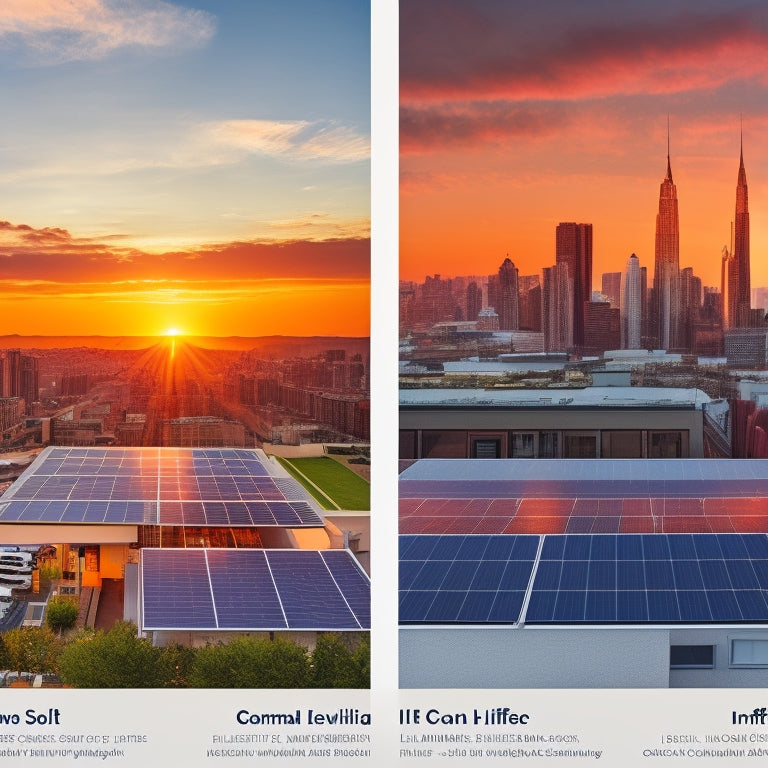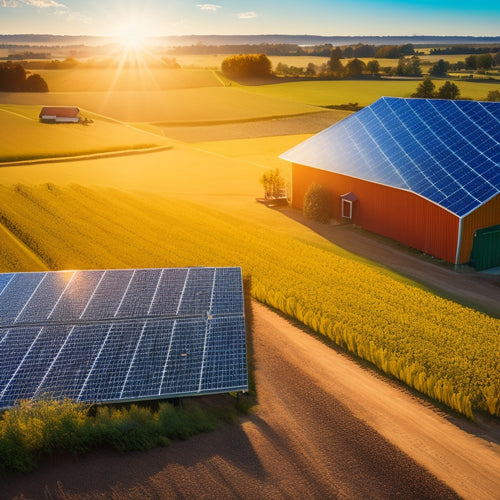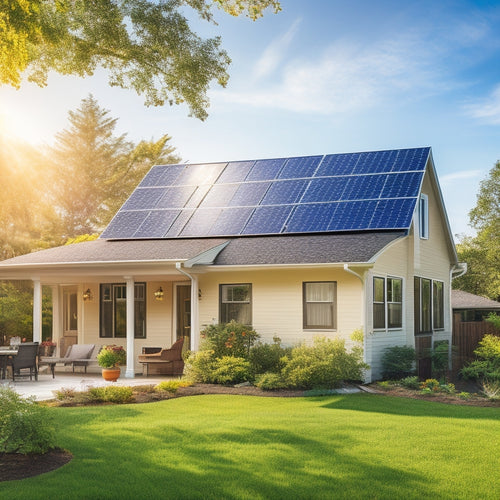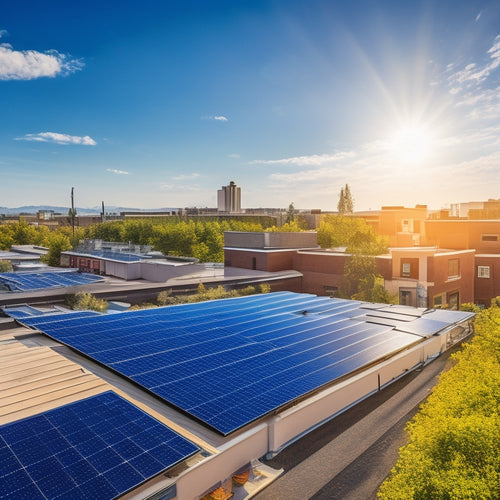
What Commercial Solar Panel Inverter Should I Choose
Share
You'll need to determine your energy usage patterns, evaluating peak usage periods and overall demand, to select the right commercial solar panel inverter that optimizes system performance and maximizes your return on investment (ROI). Consider the three main types of inverters: central, string, and microinverters, each with its unique benefits, such as high power density, versatility, and maximum flexibility. Efficiency ratings, power optimizer technology, and warranty support options also play vital roles in your decision. By understanding your energy requirements and considering these factors, you can make an informed choice - and exploring these details further will help you identify the perfect inverter for your commercial solar panel system.
Key Takeaways
- Understand your energy needs through consumption analysis and load forecasting to determine required inverter capacity, voltage, and power output.
- Choose from central, string, or microinverters based on project size, reliability, and maintenance requirements, considering factors like power density and cost-effectiveness.
- Consider power optimizer technology to maximize energy production, especially in installations with shading or panel mismatch issues.
- Evaluate inverter efficiency ratings, peak efficiency ratings, and maximum power output to ensure optimal system performance and energy production.
- Weigh warranty and support options, budget, and cost considerations, including upfront costs, installation expenses, and ongoing maintenance costs, to make an informed decision.
Understanding Your Energy Needs
Your energy usage patterns play an essential role in determining the right commercial solar panel inverter for your system. To guarantee you get the most out of your solar panel investment, you need to understand your energy needs. This involves conducting an energy consumption analysis to identify your peak energy usage periods and overall energy demand.
Load forecasting is a vital aspect of this analysis, as it helps you predict your future energy needs based on historical data and trends. By analyzing your energy usage patterns, you can determine the required inverter capacity, voltage, and power output. This information will guide your selection of a commercial solar panel inverter that can efficiently handle your energy needs.
A thorough understanding of your energy requirements will also help you optimize your system's performance, reduce energy waste, and maximize your return on investment. By getting it right, you'll be able to utilize the full potential of your solar panel system and enjoy reliable, efficient, and cost-effective power.
Types of Commercial Inverters
With a clear understanding of your energy needs, you can now focus on selecting the right commercial solar panel inverter for your system. When it comes to commercial applications, you'll encounter three main inverter types: central inverters, string inverters, and microinverters. Each type has its unique characteristics, advantages, and limitations.
Central inverters are typically used in large-scale commercial projects, offering high power ratings and efficient energy conversion. They're ideal for large, open spaces with ample room for installation and maintenance.
String inverters, on the other hand, are more versatile and suitable for a wide range of commercial applications. They're often used in rooftop installations and offer a balance between cost and performance.
Microinverters, the smallest of the three, are typically used in smaller commercial installations, providing maximum flexibility and design freedom.
When choosing an inverter type, consider factors like system size, installation constraints, and energy output requirements. Understanding the strengths and weaknesses of each inverter type will help you make an informed decision, ensuring your commercial solar panel system operates efficiently and effectively.
String Inverter Advantages
String inverters offer a unique set of advantages that make them an attractive option for many commercial solar panel systems. One of the primary benefits is their high string inverter reliability. Since each string inverter is connected to a smaller group of solar panels, the system is less prone to complete shutdowns in case of individual panel failures.
This design also enables easy string inverter maintenance, as you can replace or repair individual units without affecting the entire system.
Another advantage of string inverters is their flexibility in design. They can be easily scaled up or down to accommodate different system sizes, making them suitable for a wide range of commercial applications.
Additionally, string inverters are often more cost-effective than central inverters, especially for smaller to medium-sized systems. Their modular design also allows for easier upgrades and expansions, reducing the need for costly reconfigurations.
Central Inverter Benefits
You'll find that central inverters offer high power density, which allows for more efficient use of space and reduced installation costs.
Additionally, they're designed with efficient heat management in mind, which helps to prolong their lifespan and reduce maintenance needs.
High Power Density
Its compact design enables a central inverter to pack a higher power density, making it an attractive option for large-scale commercial solar installations. This is particularly important when you're working with limited space, as you can generate more power without sacrificing precious real estate.
With a higher power density, you can also reduce the overall footprint of your installation, which can lead to notable cost savings on infrastructure and maintenance.
High power density also translates to higher efficiency, as less energy is lost during transmission. This means you can maximize your energy output and reduce your carbon footprint.
Central inverters are designed to operate at high efficiency, often exceeding 98%, which is considerably higher than string inverters. Additionally, their compact design makes them easier to install, commission, and maintain, further reducing downtime and increasing overall system reliability.
When you need to generate a lot of power, a central inverter with high power density is an ideal choice.
Efficient Heat Management
Three key factors contribute to a central inverter's efficient heat management: a strong design, advanced cooling systems, and intelligent monitoring capabilities.
You need an inverter that can effectively dissipate heat, guaranteeing optimal thermal performance and reliability. A well-designed central inverter will have a compact layout, allowing for better airflow and reducing the risk of hotspots.
Advanced cooling technologies, such as fans, heat sinks, and liquid cooling systems, also play a vital role in maintaining a safe operating temperature.
Additionally, intelligent monitoring capabilities enable real-time temperature tracking, allowing you to identify potential issues before they become major problems. This proactive approach guarantees your inverter operates within a safe temperature range, maximizing its lifespan and performance.
Microinverter System Design
In a microinverter system design, each solar panel is paired with a dedicated inverter, allowing for maximum power harvesting and flexibility in system configuration.
This design enables you to monitor and control each panel individually, optimizing energy production and identifying underperforming panels. You'll benefit from microinverter benefits like increased energy yield, improved system reliability, and enhanced safety features.
However, microinverter systems also present installation challenges.
With more components to install and connect, installation time and labor costs may increase. Additionally, the added complexity of multiple inverters can make it more difficult to troubleshoot and maintain the system.
Nevertheless, the advantages of microinverter systems make them a popular choice for commercial solar installations.
Power Optimizer Technology
Utilizing maximum energy from each solar panel, power optimizer technology optimizes energy production at the panel level, much like microinverters. This technology guarantees that each panel operates at its maximum potential, despite any variations in performance. By doing so, power optimizers can increase your overall energy yield and reduce the impact of shading, soiling, or panel mismatch.
One of the significant power optimizer benefits is that it allows for more flexible system design and installation. With power optimizers, you can install panels in various orientations, angles, and sizes, giving you more freedom when designing your solar array.
Additionally, power optimizers can be installed on existing systems, making them an attractive option for retrofitting or upgrading existing solar installations.
When considering power optimizer technology, installation considerations are essential. You'll need to confirm that the power optimizers are compatible with your existing system and that they're installed correctly to maximize their benefits.
Inverter Efficiency Ratings
When evaluating inverter efficiency ratings, you'll come across two key metrics: peak efficiency ratings and maximum power output.
Peak efficiency ratings represent the inverter's best performance under ideal conditions, typically at a specific temperature and irradiance level.
You should consider both metrics to get a thorough understanding of an inverter's performance and how it will impact your commercial solar panel system's overall energy production.
Peak Efficiency Ratings
Your solar panel system's inverter plays an essential role in converting DC power from the panels into AC power for your business. When choosing a commercial solar panel inverter, it's vital to take into account the peak efficiency ratings, which determine how efficiently the inverter converts DC power into AC power. Peak efficiency ratings are usually expressed as a percentage and indicate the inverter's performance under ideal operating conditions.
| Manufacturer | Peak Efficiency Rating |
|---|---|
| SMA | 98.5% |
| Fronius | 98.2% |
| Schneider Electric | 97.8% |
| ABB | 97.5% |
Peak efficiency ratings are significant because they directly impact the overall performance of your solar panel system. A higher peak efficiency rating means more AC power is generated from the same amount of DC power, resulting in increased energy production and revenue for your business. When evaluating inverters, look for models with high peak efficiency ratings, as they can provide better performance and higher returns on investment. By choosing an inverter with high peak efficiency, you can guarantee your solar panel system operates at peak performance and achieves maximum energy production.
Maximum Power Output
Maximize your solar panel system's energy production by considering the maximum power output of the inverter, also known as inverter efficiency ratings. This rating determines how much power the inverter can handle during peak sun hours.
Look for an inverter with a high maximum power output to guarantee you're getting the most out of your solar panel system.
When selecting an inverter, you'll come across two types of maximum power output ratings: DC and AC. The DC rating refers to the maximum power the inverter can handle from the solar panels, while the AC rating refers to the maximum power it can supply to the grid.
Confirm the inverter's maximum power output aligns with your system's requirements to avoid energy losses.
Effective power management and performance monitoring are vital to maintaining peak system performance. Choose an inverter with built-in monitoring capabilities to track your system's energy production and identify areas for improvement.
Warranty and Support Options
A commercial solar panel inverter's warranty and support options serve as a safety net, protecting your investment from unexpected issues and ensuring minimal downtime. When evaluating warranty and support options, consider the duration of the warranty, support responsiveness, and the type of support available.
| Manufacturer | Warranty Duration | Support Responsiveness | Type of Support |
|---|---|---|---|
| Inverter A | 10 years | 24/7 phone and email | On-site repair and replacement |
| Inverter B | 12 years | 24/7 phone, email, and online chat | Remote monitoring and troubleshooting |
| Inverter C | 5 years | Business hours phone and email | Online documentation and FAQs |
| Inverter D | 15 years | 24/7 phone, email, and on-site support | Priority repair and replacement |
You should look for a manufacturer that offers an extensive warranty with a long duration, responsive support, and multiple channels for assistance. A good warranty and support package can save you time and money in the long run, ensuring your solar panel system operates at maximum efficiency.
Budget and Cost Considerations
When evaluating commercial solar panel inverters, budget and cost factors play a critical role in determining the feasibility and potential return on investment of your project.
You need to take into account the upfront cost of the inverter, which can vary markedly depending on the manufacturer, model, and features. Additionally, you should factor in the cost of installation, which may include labor, permitting, and other expenses.
Beyond the initial investment, you'll need to take into account ongoing maintenance costs, which can impact your project's long-term viability. Look for inverters with low maintenance requirements and extended warranties that can help minimize repair and replacement expenses.
You should also examine financing options, such as loans or power purchase agreements, that can help spread the cost of the inverter over time.
Frequently Asked Questions
Can I Mix and Match Different Inverter Brands in My System?
You can mix and match different inverter brands, but be cautious, as it may impact system performance. Confirm compatibility by checking communication protocols, voltage, and frequency requirements to avoid potential issues and optimize your system's overall efficiency.
How Do I Ensure Inverter Compatibility With My Existing Equipment?
You're like an expert puzzle solver, ensuring inverter compatibility with existing equipment. Review inverter specifications, focusing on voltage matching, to guarantee seamless integration. Verify compatibility with your system's unique requirements to avoid costly mistakes and optimize energy production.
What Are the Consequences of Undersizing or Oversizing My Inverter?
When sizing your inverter, you'll face consequences: undersizing reduces inverter efficiency, while oversizing shortens its lifespan, affecting your system's overall performance and ROI; you'll need to strike a balance to optimize energy harvesting and minimize downtime.
Can I Install a Residential Inverter for My Small Commercial Project?
You're considering using a residential inverter for your small commercial project, but be aware that it may not meet commercial requirements, compromising inverter efficiency and potentially leading to reduced system performance and revenue.
How Do I Monitor and Troubleshoot Inverter Performance Remotely?
Tracking your inverter's performance is like having a GPS for your energy output - you need it to steer towards success. You'll want to opt for inverters with remote monitoring capabilities and advanced inverter diagnostics to troubleshoot issues quickly and efficiently.
Conclusion
As you stand at the threshold of your commercial solar panel project, the stakes are high. The right inverter choice will release maximum energy harvesting, minimize downtime, and enhance your bottom line. The wrong one will leave you stuck in the dark, hemorrhaging revenue. The fate of your investment hangs in the balance. Will you seize the power of efficient energy production, or let it slip through your fingers? The choice is yours.
Related Posts
-

Off-Grid Solar Solutions for Sustainable Farming
Off-grid solar solutions can revolutionize your farming operations by providing energy independence and significant c...
-

How to Finance Home Solar Panels
Financing home solar panels offers several strategies to lighten your initial costs while maximizing long-term benefi...
-

Solar Energy Solutions for Small Businesses
Switching to solar energy can be a game changer for your small business. You'll enjoy significant cost savings on mon...


